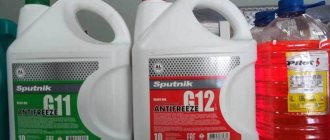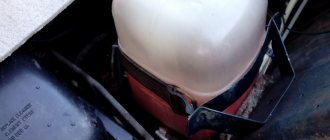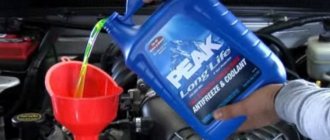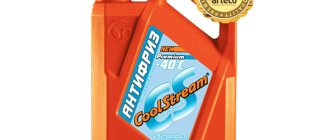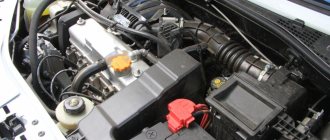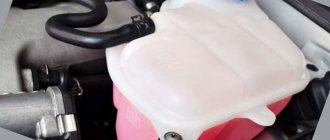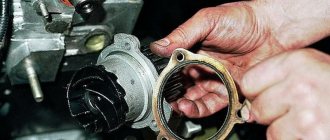The coolant on most domestic cars must be changed at least once every two years or after 60,000 kilometers, that is, it turns out that these conditions will occur earlier. Many VAZ 2109-2108 car owners believe that these recommendations should not be taken to heart, as they say, and that you can drive at least twice as long on the same antifreeze or antifreeze.
But in fact, this should be taken very seriously, because when its service life is exhausted, the coolant loses its properties: detergent, anti-corrosion, etc., which can lead to damage to the cooling channels, and this threatens serious engine repairs in the future.
Replacement frequency
According to official regulations, the manufacturer provides for replacing the coolant in cars with carburetor or injection engines every 50,000–75,000 km. Such a long time interval is explained by the fact that it is at this interval of kilometers that the coolant begins to lose its properties. The use of used antifreeze is not permitted. Changing the coolant more often than once every 50,000 is unreasonable. km.
Signs of the need for urgent antifreeze replacement
The need to replace the coolant ahead of the official schedule may arise in several cases:
- If sediment has formed in the coolant. The presence of deposits in a substance indicates that it has begun to lose its properties. If sediment settles in a thick layer at the bottom of the expansion tank or in the pipes, it means that fluid cannot circulate effectively through connectors and channels. Refrigerant deposits are more noticeable at low air temperatures.
- Increasing the crystallization temperature of the coolant. To determine at what temperature a substance will begin to freeze, you need to check the density of the refrigerant. Diagnostics is carried out using a hydrometer. In the absence of a device, the increase in crystallization temperature can be determined visually. In such a refrigerant, yellow impurities appear. It will not be visible in the liquid itself, but can be clearly seen on the expansion tank cap in the space under the hood.
- Change in color of the refrigerant and formation of a brown tint. If the substance has acquired a browner color, this indicates the presence of corrosion deposits on the metal parts of the cooling system. Discoloration may be due to the fact that antifreeze has lost its functional properties.
- Drive unit overheating. If the problem is not related to mechanical defects in the car engine, you need to check the quality of the coolant.
Replacing the coolant temperature sensor on a VAZ 2109 (injector)
- Location
- Malfunctions
- Examination
- Replacement
On any car, including the VAZ 2109, the coolant temperature sensor plays a huge role, since it largely ensures the proper, efficient operation of the engine cooling system.
Location
To repair or replace the coolant temperature sensor, the first thing you need to know is its location.
In VAZ 2109 cars, the DTOZH is located between the thermostat and the cylinder head. The device has two contacts, one of which serves for ECU readings, and the second turns on the fan.
It is also worth noting that near the DTOZH there is a single-contact sensor, which are often confused with each other.
The main function of the DTOZH is to cool the liquid. The colder it is, the richer the air-fuel mixture entering the engine will be.
Location
Malfunctions
There are several main malfunctions that lead to failure of the coolant temperature sensor. Namely:
- There is an electrical contact inside the sensor that may break or become cracked. If the contact is broken, this leads to complete combustion of the regulator. If there are cracks, the sensor can still function, but the lack of proper contact does not allow accurate information about the coolant to be transmitted;
- Sensor insulation is broken. If the wiring insulation is poor, short circuits occur. They, in turn, cause the device to burn out;
- Wires break near the sensor. Because of this, the regulator cannot turn on the fan, which leads to overheating of the car.
In the summer, a failure in the operation of the diesel engine is rarely noticed, but in winter it becomes much more difficult to start the engine.
Signs of breakdown
How can you determine that the coolant temperature sensor has stopped working normally or has completely burned out?
- The cooling fan turns on randomly even at normal engine temperature. But in fact, the fan should only turn on when the power unit overheats.
- It's difficult to start the engine when it's hot. The cooling system is responsible for regulating the temperature, but a faulty sensor does not allow obtaining objective data and a signal to start a particular operating mode.
- Fuel consumption increases noticeably. This is caused by overloading the engine, which has to drive at elevated temperatures. Because of this, fuel consumption is increasing.
Before making final conclusions regarding the breakdown or malfunction of the DTOZH on the VAZ 21099, be sure to carry out verification activities.
Examination
Today, VAZ 2109 car owners use two methods to check the condition of the coolant temperature sensor. Let's say right away that the second one is more reliable, but the first one is easier. Decide for yourself which of the methods presented below to use.
According to the table, check whether the resistance corresponds to that required at a particular temperature of coolant or boiling water.
Level control and required volume
Before replacing the working fluid, the car owner must know the power of the cooling system of the “nine” and how much coolant it will use in order to purchase the required amount of fluid for the task at hand. When replacing, approximately 8.7 liters of antifreeze will fall into the plastic container under the lid. If you do not completely drain the working substance from the system, you will get about 7-7.5 liters. As for checking the level, it is carried out by marking the expansion tank in the engine compartment. Please note that when the car engine is warm, the volume of fluid may increase. Therefore, before checking, turn off the engine and let it cool.
Ideally, the refrigerant level should be between two marks - MIN and MAX.
For what reasons is coolant consumed?
There are several reasons why the volume of coolant in the cooling system decreases:
- Low sub-zero temperatures. In severe frost, the liquid decreases in volume. The reason for this cannot be called a leak, but car owners in winter often confuse this problem with a fluid leak. In the cold season, experts recommend adding coolant to the system.
- Formation of cracks and damage in the expansion tank or on its cover. As practice shows, if the defect on the tank is insignificant, it will not be easy to detect it visually. The crack may look like a scratch. Detailed diagnostics will be required. To determine the location of the leak, you will need a special dye added to the liquid.
- Insufficient tightness of linear connections or damage to pipe joints. This problem can be detected visually. The defects show wet traces of refrigerant. If the defect is minor, it is impossible to detect it using visual diagnostics. You will need to add dye to the refrigerant.
- The thermostat or gasket is damaged. If there is damage to the seal on the unit, fluid will leak out and the amount of fluid in the cooling system will decrease over time.
- Damage to the radiator device of the heating system. During operation, the cooler wears out. If the service life has already expired, the coolant may leak through cracks formed in it or the hose connected to it. It is not recommended to add fluid; the cooling radiator should be replaced.
- Presence of defects on the cylinder head gasket. If there is damage, there is a leak. As a result, the antifreeze will begin to mix with the engine oil, which will enter the coolant. The malfunction can be eliminated by replacing the cylinder head gasket.
Topping up
The refrigerant charging procedure is performed with a cold engine. To add antifreeze, open the hood of the car and unscrew the cap of the expansion tank. The required amount of liquid is poured into the container, then it is twisted and sealed.
If you do not know what fluid was used before, it is better to change it. Because mixing different types of refrigerants leads to a loss of properties of the substance.
What to choose?
What do we choose?
Many car owners often wonder about the choice of coolant - antifreeze or antifreeze: which is better? Let's try to figure out what's what without going into deep truths.
Antifreeze
- In fact, all coolants are and are called antifreeze. And antifreeze is no exception to the rule. In fact, antifreeze is just the name of one of the types of antifreeze developed in our area, for our area and for our cars.
- In terms of its performance and characteristics, antifreeze is in many ways inferior to other antifreezes.
- The price of antifreeze is much lower than other coolants.
- Antifreeze is more common among domestically produced cars.
Antifreeze
- There are very, very many antifreezes in the world. They differ in composition, base, color, and so on.
- Various antifreezes include various special additives that help better maintain the car's cooling system and at the same time increase the service life of the antifreeze itself.
- The cost of antifreeze is higher than antifreeze, and it is quite widespread.
Conclusion
Summarize. Antifreeze or other antifreeze? So:
- Antifreeze is undoubtedly better in quality.
- BUT antifreeze is much more practical for several reasons.
- Antifreeze was SPECIALLY designed for our climate and our cars.
- Antifreeze is available in almost every domestic car that passes you. And this can sometimes save (in case of a breakdown on the road).
- There is enough antifreeze for the car to function normally and the cooling system to work as expected.
It is more practical and cheaper (which is very important) to use antifreeze.
Instructions for self-replacement
Below we will discuss how to change the coolant in a Nine.
What will be required for replacement?
If you are replacing the refrigerant yourself, do the following:
- key 8;
- 12 mm hex key;
- a cylinder or bucket into which you can fill the used refrigerant;
- If necessary, distilled water or a special solution for flushing the cooling system.
How to drain?
In order to completely drain the Antifreeze system on a VAZ 2109, you must perform the following steps:
- The car drives into a garage with a pit or onto an overpass. The surface on which the machine stands must be level. If it is not possible to provide such conditions, then the front of the car should be slightly higher. To do this, place the front wheels on a jack.
- Start the vehicle's powertrain and turn the heater control knob to the far right so that the heater blows out hot air.
- Stand under the car and remove the engine crankcase cover. To do this, unscrew the mounting screws.
- Stop the engine and loosen the negative battery terminal bolt. This is necessary to prevent short circuits during emptying.
- Remove the filler cap from the expansion tank. This will reduce the pressure when draining the exhaust gases.
- Place a container to collect “waste” under the drain plug on the cylinder block. After unscrewing the lid, the process of emptying the container of impurities will begin.
- After draining the water, replace the lid. Now you need to drain the working fluid from the radiator. To do this, unscrew the plastic cap on the radiator, after placing a container under it. Once the water has drained, screw the lid back on.
How to properly wash?
If the drained coolant is too dirty with traces of sediment, it is necessary to flush the cooling system. You can use distilled water or a special cleaner, which is sold at any car store.
The correct washing procedure is as follows:
- Distillate or rinse aid is poured into the VAZ 2109 power unit through the filler hole located on the tank under the hood. To do this, unscrew the cap and add enough fluid until the level is between the MIN and MAX marks on the tank.
- Start the car engine and let it idle for about ten minutes.
- Stop the engine and repeat the draining process.
- Assess the quality of the drained liquid. If it is too dirty and has traces of sediment, the washing procedure is repeated until the water becomes more or less clear.
Aveo Show user in his video showed the procedure for replacing antifreeze and cleaning the cooling system on a VAZ 2109.
How to fill?
Antifreeze must be filled as follows:
- Unscrew the reservoir cap in the engine compartment. For greater convenience, you can install a watering can in it.
- Make sure all plugs (drain plug and radiator cap) are securely tightened. Check the tightness of hoses and pipelines. Make sure the thermostat is in working order.
- Fill the expansion tank with fresh fluid. The coolant level should be between the MIN and MAX marks.
- Close the expansion tank cap and start the engine.
- Let the engine idle for approximately 10 minutes.
- Go under the vehicle's chassis and check for coolant leaks.
What are the consequences of an untimely change?
If the replacement period is not met, the car owner will face the following problems:
- Antifreeze will not be able to perform the functions assigned to it. This will lead to the fact that at low temperatures the car's heating system will not work as efficiently. In some cases, the heater does not work at all.
- The circulation of the working fluid will be impaired due to deposits in the car radiator connections and the radiator assembly. This will lead to excessive heating of the drive. Prolonged use of the machine with an overheated engine can lead to machine failure.
Some features of the VAZ 2109 cooling system
- The VAZ 2109 CO is liquid, with a total volume of 7.8 liters, if you count it together with the stove. The type of system is closed, it is sealed. The operating pressure in the cooling system is maintained at about one atmosphere. Due to the increased pressure, the liquid in it boils at a higher temperature than at normal pressure. This significantly increases the service life of the CO itself, as well as the engine.
- Liquid circulation is carried out forcibly, that is, using a pump or pump. The CO “nine” is equipped with a centrifugal pump. Its body is made of aluminum. The pump mechanism operates from a timing belt drive. The rotation of the pump shaft is carried out on double-row ball bearings. Moreover, the role of the bearing cage is played by the pump roller; it does not have its own.
- The mechanism is filled with the appropriate lubricant (Litol) during manufacture. While it is functioning, it is not being maintained; such a possibility is not provided for by the design. If it breaks, it cannot be repaired, therefore, it is recommended to completely replace the pump if it breaks. In such systems, for greater reliability, they try to replace the pump when changing the timing belt.
- Since CO "nine" is liquid, this liquid needs to be replaced from time to time. The VAZ 2109 cooling system is undemanding in terms of antifreeze quality. However, the Antifreeze A 40 that was produced for such COs in the last century is no longer produced. What is produced under this brand, alas, does not comply with the GOST standards according to which this coolant was produced.
- Many auto mechanics do not recommend its use; from what is recommended by AvtoVAZ, it is quite possible to choose a replacement. As a last resort, purchase imported antifreeze with a composition that meets the requirements. But water cannot be used at all as antifreeze; it will leave a layer of scale on the walls of all pipelines of the system, and aluminum parts will undergo active corrosion.
- For coolant, working tO is +85O – +95OC. Additionally, at a temperature of about +99°C, the contacts in the fan relay close. The engine electric fan stops working when the relay sensor contacts open, this is +93°C. This means that, focusing only on the fact of turning the fan on and off, you can make a correct conclusion about the temperature in the system. Even with a failed (or missing) thermometer on the dashboard.
- The relay temperature sensor is installed in the cylinder head. There is a thermometer on the instrument panel that shows this temperature, signaling possible overheating. While the engine is running, liquid flows from the cooling jacket of the cylinder head and block to the radiator, where it picks up heat or to the thermostat.
- The cooling system of the VAZ 2109 has a small and large circulation circle, the separation occurs at the thermostat. Which is convenient, especially when you need to quickly warm up the engine at low air temperatures. The valve closes, liquid flows only through a small circuit. As the temperature rises, the thermostat valve allows coolant to flow into the large circle pipes.
- During engine operation, during combustion of the fuel mixture, temperatures reach 2,000°C and this happens intermittently. Poor performance of the cooling system not only leads to premature destruction of the cylinder-piston group due to thermal overload. The lubricant dries out and burns out, fuel costs increase with decreasing efficiency.
- Hypothermia leads to the accumulation of condensation, which washes away the lubricant (gasoline is a good solvent), enters the crankcase, mixes with the oil, diluting it. This is another reason to keep the CO in order, otherwise expensive engine repairs cannot be avoided.
- In addition to cooling the engine, CO heats the air in the radiator and cools the turbine (if there is a turbocharger), and also cools the oil and working fluid in the automatic transmission.
- For greater driving comfort, you should also do a little tuning of the system. You can increase the efficiency and reliability of operation by installing a pump that has an impeller with many blades. The fan is also desirable to be more powerful, six-bladed.
- It would be good if a manual fan start/stop system is installed, in addition to the relay, the sensor of which may fail. An additional fan on/off relay would also be useful; in city traffic jams, this will add peace of mind to the driver and reliability of the system.



